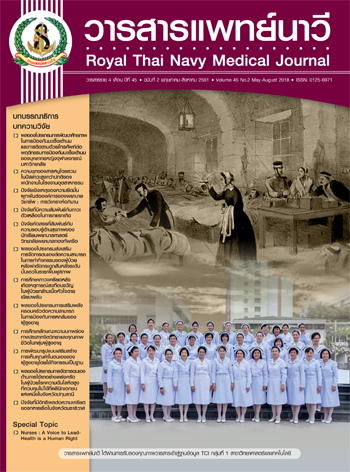Prevalence of Elevated Total Arsenic in Urine of Industrial Plant Workers
Main Article Content
Abstract
This study was a cross-sectional method. This research aimed to study the prevalence elevated of total arsenic in urine of the workers who work in oil and gas production industrial, both onshore and offshore including male and female from age 20 - 60 years. Material and method used the Bangkok Hospital and Bangkok Prapadaeng Hospital medical records of total arsenic in urine and / or inorganic arsenic and methylated metabolites from January 1, 2013 to December 31, 2015 by using N-Health Laboratory facilities analysis, the total 574 workers. The result revealed that the prevalence of total arsenic and inorganic arsenic and methylated metabolites which were higher than normal level in workers who work in onshore/offshore in oil and gas production industrials was 25.96 percent and 4.76 percent, respectively. Conclusion; The workers who work onshore and offshore in oil and gas production industrial had elevated of total arsenic in urine. Suggestion to conduct prospective study and walkthrough survey in the future.
Article Details

This work is licensed under a Creative Commons Attribution-NonCommercial-NoDerivatives 4.0 International License.
References
Xie Y, Trouba KJ, Liu J, Waalkes MP, Germolec DR. Biokinetics and subchronic toxic effects of oral arsenite, arsenate, Monomethylarsenic acid, and Dimethylarsenic acid in v-Ha-rasTransgenic (Tg.AC) Mice. Environ Health Perspect 2004;112(12):1255-63
Byun K, Won YL, Hwang YI, Koh DH, Im H, Kim EA. Assessment of arsenic exposure by measurement of urinary speciated inorganic arsenic metabolites in workers in a semiconductor manufacturing plant. Ann Occup Environ Med 2013;25(1):21-5
บริษัท ปตท. จำากัด มหาชน. สารานุกรม เปิดโลกปิโตรเลียมและพลังงานทดแทน. สมุทรปราการ: เกียวโด-เนชั่น-พริ้นติ้ง เซอร์วิส; 2553. หน้า 29, 51
Cöl M, Cöl C, Soran A, Sayli BS, Oztürk S. Arsenic-Related Bowen’s disease, palmar keratosis, and skin cancer. Environ Health Perspect 1999;107(8):687-9
Bakke T, Klungsoyr J, Sanni S. Environmental impacts of produced water and drilling waste discharges from the Norwegian offshore petroleum industry. Mar Environ Res 2013;92:154-69
Xu H, Han S, Bi X, Zhao Z, Zhang L, Yang W, et al. Atmospheric metallic and arsenic pollution at an offshore drilling platform in the Bo Sea: a health risk assessment for the workers. J Hazard Mater 2016;304:93-102
อดุลย์ บัณฑุกุล. สารหนู. ใน อดุลย์ บัณฑุกุล และคณะ, บรรณาธิการ. ตำาราอาชีวเวชศาสตร์. กรุงเทพมหานคร: โรงพิมพ์ราชทัณฑ์; 2554. หน้า 709-10
Ladou J. Current occupational & environmental medicine. 4th ed. United States: The Mc-Graw Hill Companies; 2007. p. 232-33, 414-16, 647, 613-28
Kjeldsberg CR, Ward HP. Leukemia in arsenic poisoning. Annals of Internal Medicine 1972;77:935-7
Klaassen CD. Casarett & Doull’s toxicology: the basic science of poisons. 6th ed. United States: The Mc-Graw Hill Companies; 2001. p. 820-1
American Conference of Governmental Industrial Hygienists (ACGIH). Documentation of the threshold limit values for biological exposure indices. 7th ed. Cincinnati: ACGIH; 2013
Witter R, Stinson K, Sackett H, Putter S, Kinney G, Teitelbaum D, et al. Potential exposure-related human eath effects of oil and gas development: a literature review (2003–2008). p.18-22. [Internet]. [cited 2016 November 1]. Available from: file:///D:/ Documents/Downloads/sub17att2.pdf
Navas-Acien A, Francesconi KA, Silbergeld EK, Guallar E. Seafood intake and urine concentrations of total arsenic, dimethylarsinate and arsenobetaine in the US population. Environ Res 2011;111(1):110-8
Vimercati L, Gatti MF, Gagliardi T, Cuccaro F, De Maria L, Caputi A, et al. Environmental exposure to arsenic and chromium in an industrial area. Environ Sci Pollut Res Int 2017;24(12):11528-35
Hsueh YM, Hsu MK, Chiou HY, Yang MH, Huang CC, Chen CJ. Urinary arsenic speciation in subjects with or without restriction from seafood dietary intake. Toxicol Lett 2002;133(1):83-91
PTT Distribution Service Center. Knowledge: pipeline pigging ส่งก๊าซ ปตท. ส่วนวิศวกรรม ซ่อมบำารุงระบบท่อ. [Internet]. [cited 2016 November 1]. Available from: https://dscng.pttplc.com/(S(b0gbvegrcttuokfqbwlaem4p)/Knowledge/Knowledge.aspx
Occupational Safety and Health Administration (OSHA). Assigned protection factors for the revise respiratory protection standard: OSHA 3352-02 2009. [Internet]. [cited 2016 November 1]. Available from: https://www.osha.gov/Publications/3352-APF-respirators.pdf


